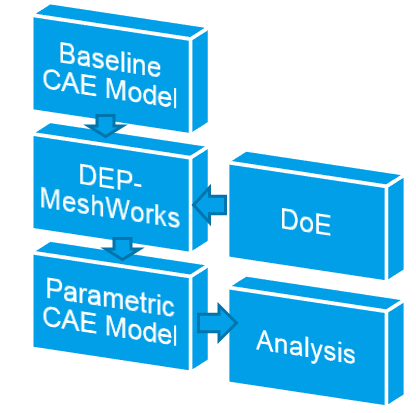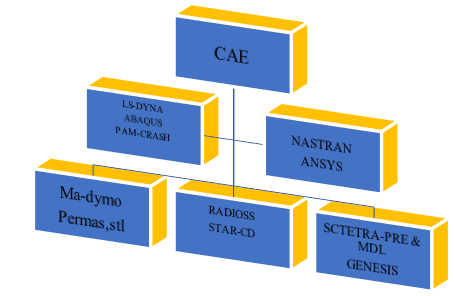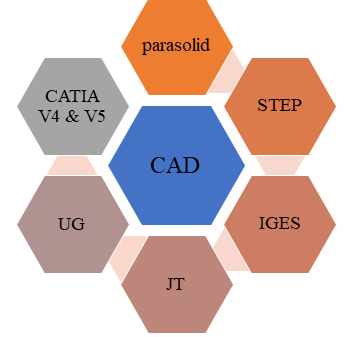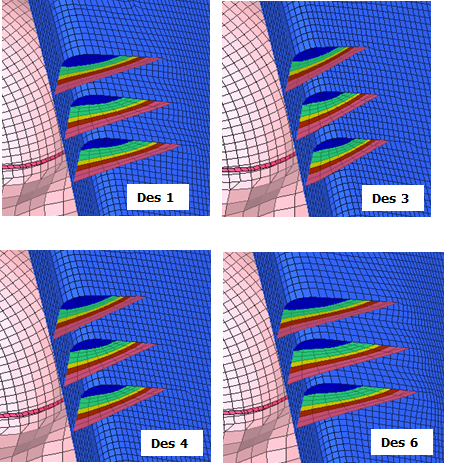
MULTI DISCIPLINARY OPTIMIZATION MDO
The MeshWorks toolsets possess various functionalities that enable the performance analysis and optimization of structures across multiple disciplines. The parametric and non- parametric CAE models in DEP MeshWorks allow for Multi-Disciplinary Optimization (MDO) that can achieve design objectives, reduce product weight, and minimize manufacturing expenses. MeshWorks streamlines the entire process of concept design, analysis, and optimization through its MDO capabilities.
Functions:
MeshWorks' parametric models can generate numerous sets of analysis data from a Design of Experiments (DOE) matrix with great reliability. The tool can run in batch mode and easily integrate into automated workflows. It also offers ready interfaces for major optimization software like Isight, ModeFrontier, Heeds, Optimus, LSOPT, and others.
One of MeshWorks' strengths is its ability to carry out multi-disciplinary optimization by unifying control blocks that parameterize different models (CFD, NVH, and Crash). The tool can also parameterize FE models and produce multiple designs while specifying the design variables and their limits for various disciplines. The designs are then solved by FE solvers and used to generate an input-output matrix that feeds into the Optimizer to obtain the optimized design.
MeshWorks can be used for both one-time design changes or as a parameter for DOE/Optimization studies. It features a comprehensive parameterization module that addresses various aspects like shape, gauge, features, design enablers, welds, adhesives, etc. Additionally, a high degree of automation for morphing, parameterization, and design enablers is achievable.
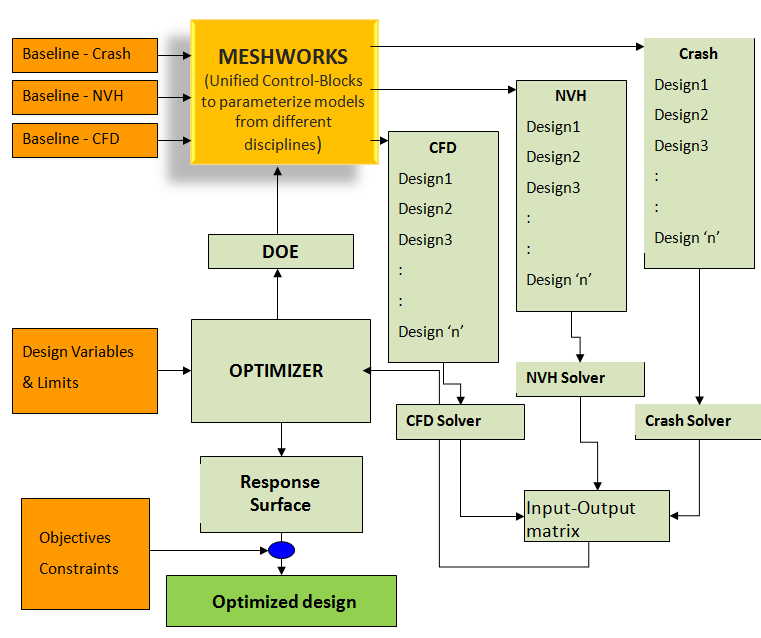
TIME-SAVING MDO
MeshWorks-based Parametric and Non-Parametric CAE models are instrumental in enabling Multi-Disciplinary Optimization (MDO) and making it an everyday process. By utilizing parametric models in MeshWorks, MDO becomes more efficient, and a significant amount of time and effort is saved in each discipline's analysis (such as Crash, NVH, Durability, CFD, etc.). This is because the parameters created for one discipline can be quickly adapted to other discipline models. Moreover, MeshWorks allows for generating multiple analysis datasets based on a Design of Experiments (DOE) matrix, facilitating both nominal and robust optimization studies.
The MDO process is further accelerated using MeshWorks' parametric Reduced Order Models (ROM), which help save time and effort while producing reliable results.
Topology Optimization – MDO
MeshWorks serves as both a Pre and Post processor for topology optimization process workflows. As a pre-processor, it allows users to remove ribs and bosses in complex geometries and create minimalistic designs using morphing approaches at both component and full vehicle levels. It considers manufacturability criteria for castings, extrusions, and stampings, and can create design space on the minimalistic design in a highly automated fashion.
MeshWorks also includes several automated functions for creating Concept FE models that represent the load paths suggested by Topology optimization results. Users can create alternative design suggestions, such as ribs, new members, and joints, in addition to increasing or decreasing wall thickness as suggested by load paths. The creation of new parts from scratch or reinforcements like doublers and bulkheads that represent load paths is highly automated as well.
MeshWorks is capable of handling such topology optimization post-processing at both the component and full system levels, making it a versatile tool for engineers seeking to optimize designs for maximum performance and manufacturability.
Key MDO features:
- One of MeshWorks' unique features is its highly automated parameter transposition from master models to other discipline models.
- With a wide range of parameters for diverse problems, MeshWorks maximizes the design space, thereby optimizing designs to the fullest extent.
- MeshWorks stands out with its use of Parametric Reduced Order Model (ROM) techniques.
- Integration with major optimization software like Isight, ModeFrontier, Heeds, Optimus, LS-Opt, and others enhances workflow efficiency, making the optimization process seamless.
- MeshWorks includes a quick feature removal tool that can handle complex geometries with ease.
- MeshWorks has the ability to create body-fitted design spaces with a high degree of automation.
- MeshWorks can convert a full system iso surface model to a beam model, providing additional flexibility in the optimization process.
- MeshWorks includes advanced Concept FE tools such as members, joints, ribs, doublers, bulkheads, etc. for castings, stampings, extrusions, and plastics, allowing for a comprehensive approach to design optimization.
Benefits:
MeshWorks offers a variety of built-in features that can handle multi-domain models, including the ability to import both CAD and FE models. It supports standard CAD tools such as CATIA and UNIGRAPHICS, as well as FE models for various types of analysis such as crash, NVH, stress durability, fatigue, and multi-body dynamics.
Furthermore, MeshWorks supports standard CAD handling formats like IGES, STEP, and Para solid. At the FE model level, it can integrate with major crash tools such as LS-DYNA and PAM-CRASH, as well as other NVH and durability tools. Additionally, MeshWorks supports other pre-processing tools cards while exporting.
MeshWorks also provides a Standard Template Library (STL) for users to create algorithms for customization.
Users can easily create parametric models that account for all aspects of design features and parameters. Design optimization for weight reduction or performance improvement is also possible. CAD morphing can be easily applied to achieve optimum designs and delivered to the design team. Moreover, MeshWorks simplifies the process of changing the geometrical dimensions of a full vehicle by importing control blocks, which can be a tedious task in other tools.
- The MDO Optimization process in MeshWorks allows for the achievement of Weight and Cost targets while maintaining balanced performance across multiple disciplines.
- By integrating the Reduced Order Model (ROM) approach, MeshWorks can significantly reduce analysis run time and MDO turnaround time.
- MeshWorks MDO methodology incorporates Manufacturing, Packaging, Human factors, and other design aspects alongside Structural considerations for a balanced optimization.
- Most functions in MeshWorks are highly automated, resulting in tremendous time reduction in pre and post processing.
- MeshWorks workflow allows for the creation of a valid concept FE model directly from topology results, bypassing the need for a CAD designer and resulting in significant time savings.
- MeshWorks provides a complete set of tools for handling both component and assembly level design changes, including components manufactured through different processes such as castings, extrusions, and stampings.

